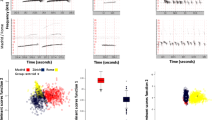Summary
A discriminant analysis of the call structure completely separates threeCorvus taxa (levaillantii andjaponensis of the ‘macrorhynchos group’,splendens) inhabiting the southern slopes of the Himalayas (Nepal, Kashmir). The acoustic differences are considered taxonomically relevant, indicating species boundaries. Therefore the Jungle Crows of lower and upper Nepal (contact zone at around 2,000 m) are assigned to two biospecies (C. japonensis andC. levaillantii), as is consistent with morphological, ecological and parasitological data. It appears possible to extrapolate the findings regarding call structure to the systematics of other ‘macrorhynchos’ populations as distant as the Russian Far East, and those regarding mallophagan parasites to large areas of SE Asia; regarding the vocal characteristics, however, further clarification is needed.
Zusammenfassung
Über die Gliederung der ostasiatischen Dickschnabelkrähen (Corvus macrorhynchos s.l.) in Biospezies besteht bisher keine einhellige Meinung. In dem großen Verbreitungsgebiet zwischen Indien, Japan und Timor werden gegenwärtig eine, zwei oder drei Arten anerkannt. Hier versuchen wir, in akustischen Merkmalen artanzeigende Merkmale zu finden. Eine Diskriminanzanalyse der Rufstruktur (76 Parameter) trennt dreiCorvus-Taxa (levaillantii undjaponensis aus der ‘macrorhynchos-Gruppe’,splendens) von der Südabdachung des Himalaya (Nepal, Kashmir) vollständig voneinander. BeiC. japonensis bleiben die trennenden Merkmale über große geographische Gebiete konstant. Die akustischen Unterschiede werden als taxonomisch relevant angesehen; sie zeigen Artgrenzen an. Folglich werden die Dickschnabelkrähen aus den Tief- und Hochlagen Nepals (Kontaktzone um 2 000 m) zwei Biospezies zugeordnet (C. japonensis undC. levaillantii), in Übereinstimmung mit morphologischen, ökologischen und parasitologischen Daten. Taxonomische Extrapolation der Befunde auf die Systematik anderer ‘macrorhynchos’-Populationen erscheint über die Rufstruktur (bis zum Fernen Osten Rußlands) und über Federling-Parasiten (Mallophaga) auf große Teile SO-Asiens möglich, bedarf aber für die stimmlichen Merkmale noch weiterer Klärung. Wahrscheinlich müssen immacrorhynchos-Komplex mindestens drei biologische Arten anerkannt werden (C. japonensis, C. levaillantii, C. macrorhynchos s. str.).
Similar content being viewed by others
References
Allenbacher, R., Böhner, J. & Hammerschmidt, K. (1995): Individuelle Merkmale im „krah“-Ruf der NebelkräheCorvus corone cornix. J. Ornithol. 136: 441–446.
Ali, S. (1962): The birds of Sikkim. Oxford.
Ali, S. & Ripley, S. D. (1972): Handbook of the Birds of India and Pakistan. 5. Oxford.
Biswas, B. (1963): The birds of Nepal, Part 11. J. Bombay nat. hist. Soc. 60: 638–654.
Deignan, H. G. (1963): Checklist of the birds of Thailand. U. S. Nation. Mus., Smithsonian Inst., Bull. 226.
Fleming, R. L. & Traylor, A. M. (1968): Distributional notes on Nepal birds. Fieldiana: Zool. 53: 145–203.
Glutz von Blotzheim, U. & Bauer, K. (1993): Handbuch der Vögel Mitteleuropas, 13. Wiesbaden.
Grimmett, R., Inskipp, C. & Inskipp, T. (1998): Birds of the Indian Subcontinent. London.
Hammerschmidt, K. & Todt, D. (1995): Individual differences in vocalisations of young Barbary macaques (Macaca sylvanus): A multi-parametric analysis to identify critical cues in acoustic signalling. Behaviour 132: 381–399.
Hartert, E. (1929): Types of the birds in the Tring Museum. Novit. Zool. 35: 42–58.
Inskipp, T., Lindsay, N. & Duckworth, W. (1996): An annotated checklist of the birds of the Oriental Region. Sandy.
Klockenhoff, H. (1969a): Zur systematischen Aufgliederung der Myrsideen (GattungMyrsidea Waterston, 1915; Menocopidae: Mallophaga) als Parasiten von Unterarten der DschungelkräheCorvus macrorhynchos Wagler, 1827. Zool. Anz. 183: 379–442.
Klockenhoff, H. (1969b): Zur Verbreitung der Mallophagen der GattungMyrsidea Waterston auf der DschungelkräheCorvus mcrorhynchos Wagler. Z. zool. Syst. Evol.forsch. 7: 53–58.
Madge, S. & Burn, S. (1993): Crows and Jays. London.
Martens, J. & Eck, S. (1995): Towards an ornithology of the Himalayas. Systematics, ecology and vocalizations of Nepal birds. Bonner Zool. Monogr. 38.
Mauersberger, G. & Mey, E. (1993): Mallophagen und Vogelsystem — Beitrag zur Diskussion der „Parasitophyletik“. Mitt. Zool. Mus. Berlin 69, Suppl. Ann. Orn. 17: 3–30.
Palestrini, C. & Rolando, A. (1996): Differential calls by Carrion and Hooded Crows (Corvus corone corone andC. c. cornix) in the Alpine hybrid zone. Bird Study 43: 364–370.
Peters, J. L. (1962): Checklist of the Birds of the World. 15. Mus. Comp. Zool., Cambridge, Mass.
Roberts, T. J. (1992): The birds of Pakistan. Vol. 2. Oxford.
Sibley, C. G. & Monroe, B. L. (1990): Distribution and taxonomy of birds of the World. New Haven.
Stanford, J. K. & Mayr, E. (1940): The Vernay-Cutting Expedition to northern Burma. Ibis 4: 679–711.
Stresemann, E. (1943): Die GattungCorvus in Australien und Neuguinea. J. Ornithol. 91: 121–135.
Vaurie, C. (1959): The birds of the Palearctic Region. Order Passeriformes. A systematic reference. London.
Wolters, H. E. (1977): Die Vogelarten der Erde. 3. Lfg. Hamburg.
Author information
Authors and Affiliations
Additional information
Results of the Himalaya Expeditions of J. Martens, No. 224. — For No. 225 see: Stuttgarter Beitr. Naturk. A598, 1999.
Rights and permissions
About this article
Cite this article
Martens, J., Böhner, J. & Hammerschmidt, K. Calls of the Jungle Crow (Corvus macrorhynchos s.l.) as a taxonomic character. J Ornithol 141, 275–284 (2000). https://doi.org/10.1007/BF02462237
Accepted:
Published:
Issue Date:
DOI: https://doi.org/10.1007/BF02462237




